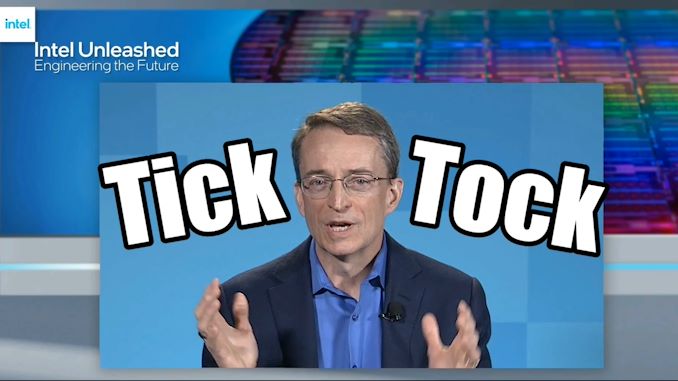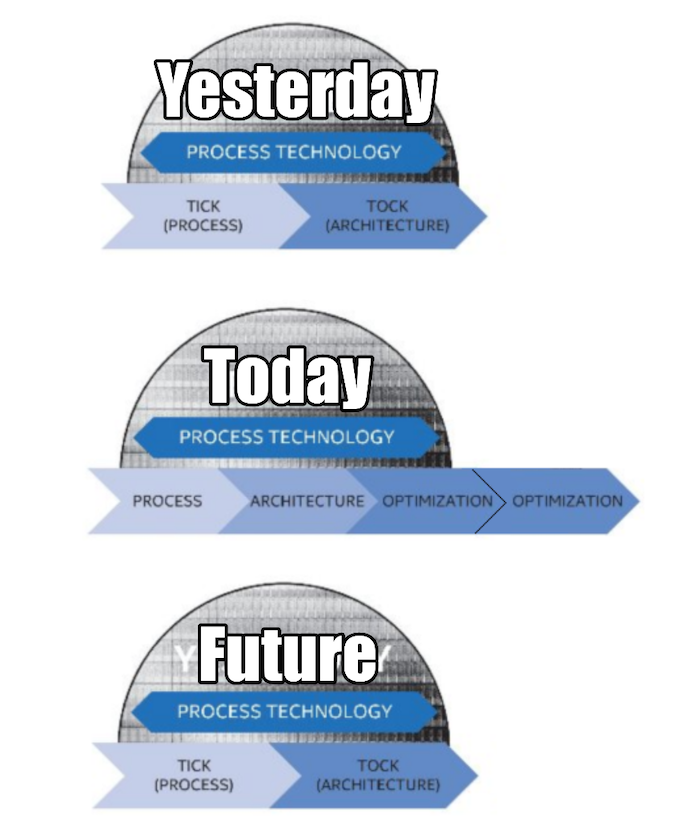Intel to Revive ‘Tick-Tock’ Model, Unquestioned CPU Leadership Performance in 2024/2025
by Dr. Ian Cutress on March 23, 2021 6:31 PM EST- Posted in
- CPUs
- Intel
- Tick-Tock
- 7nm
- Chiplets
- Pat Gelsinger
- Meteor Lake
- Tiles

As part of today’s announcements, during Intel’s Q&A session after the prepared remarks, CEO Pat Gelsinger explained how Intel is going to revive its fortunes when it comes to its leading edge compute products. One of Gelsinger’s mantras seems to be that unquestioned leadership products bring unquestioned leadership margins for those products, and for Intel to execute, it needs to return to its days of old.
In the past, through the 1990s, 2000s, and into the 2010s, Intel’s manufacturing philosophy was known as ‘Tick-Tock’. This means that for every product generation, the leading edge compute hardware was either a Tick (process node enhancement), or a Tock (microarchitecture enhancement). Each generation would alternate between the two, allowing Intel to take advantage of a familiar design on a new process node, or using a mature node to enable a new performance-focused design. That policy was scuppered when delays to Intel’s 10nm forced Intel into more of a Tick-Tock-Optimization-Optimization-Optimization model.
Today CEO Pat Gelsinger stated that at Intel’s core it has to re-establish the Tick-Tock model that enabled repeated leadership in the CPU ecosystem, buoyed by a healthy CPU roadmap. Part of this is re-establishing discipline in Intel’s ranks to continually provide both microarchitecture updates and process node updates on a regular expected cadence. Pat stated as part of the call that Intel will look towards a confirmed yearly process node improvement, and as a result, there might be a lot of Ticks in the future, with a push to more Tocks as well.
On top of this commentary, Pat Gelsinger also stated that Intel’s CPU roadmaps are already baked in through 2021, 2022, and 2023. The company is thus looking to 2024/2025 for ‘unquestioned CPU leadership performance’, which traditionally means the fastest processor for single thread and multi-thread workloads. This is for sure a laudable goal, however Intel will also have to adapt to a changing landscape of chiplet processor designs (coming in 2023), enhancing on-die accelerators (GNA already present), and also what it means to have leadership performance – in the modern era, leadership performance doesn’t mean much if you’re also pushing lots of Watts. Intel stated that its 7nm process is now comfortably on track to deliver Meteor Lake, a client CPU using tiles/chiplets, in 2023, however we are likely looking to a 7nm variant or even external processes for a 2024/2025 product. Intel has also stated that it is looking to consider the core of its leading edge compute on external foundry processes, although one might argue that this doesn’t explicitly say ‘CPU’.
It is also worth noting that Intel/Gelsinger isn’t calling its disaggregated silicon as ‘chiplets’, and prefers to use the term ‘tiles’. This is because Intel’s tiles amount to long wires across 3D packaging technologies like EMIB and Foveros, compared to package-based multi-die interconnect that require buffers as well as control fabric. Tiles by this definition are more costly to implement than chiplets, and have additional thermal considerations by having high-powered silicon close together, so it will be interesting to see how Intel balances these new packaging technologies with the more cost-sensitive elements of its portfolio, such as client processors.
It’s been known that Intel’s microarchitecture teams haven’t been idle waiting for 10nm to come through the pipe, with a number of designs ready and waiting to go for when the process node technology matures. With any luck, if Intel can get a headwind with 7nm, when 2024 rolls around it might all come thick and fast.











109 Comments
View All Comments
GeoffreyA - Monday, April 5, 2021 - link
That's right, but I suppose that's the tradeoff they were willing go for.Oxford Guy - Tuesday, April 6, 2021 - link
You're debating apples and oranges.The bottom line is that the architecture was designed for high clocks to compensate for the low IPC.
That AMD chose to go super-cheap (28nm density library, 2 FPU cores, flaccid socket standards) is not the point. It's just historical anecdote, although it also helped to make Zen seem more impressive than it would have had AMD bothered to offer anything after Piledriver in the performance space.
GeoffreyA - Tuesday, April 6, 2021 - link
"The bottom line is that the architecture was designed for high clocks to compensate for the low IPC."True, can't disagree with that.
"it also helped to make Zen seem more impressive"
Agree there too. I recall quite strongly that when Zen's IPC was being unveiled in 2016/7, you know that 52%, I thought, "Well, that's fantastic, but the comparison is against Bulldozer, so obviously the value will be high." Having said that, I still believe that Zen was an impressive product. In a single iteration, you've got a design from scratch, reaching just short of Skylake IPC, the latter going all the way back to P6 in the 90s. How many iterations of polish is that? Zen was impressive to cover the ground in one stroke, and Zen 2, as I expected, being the first touching up, surpassed Skylake just like that.
GeoffreyA - Wednesday, March 24, 2021 - link
"Remember Bulldozer?"Exactly. Never underestimate.
Zizy - Wednesday, March 24, 2021 - link
Bulldozer lesson goes the other way around.Phenom2 couldn't really scale further and on servers AMD had MC that was great with highly parallel workloads and not much else; so they were competitive but they were clearly underdogs and sliding behind. So, much before launch, AMD was bragging about how BD will drive over Intel in everything and offer tremendous gains over their MC.
It was a spectacular disaster, significantly worse than promised. Zen launched to way less fanfare and was a much better chip than promised.
Obviously, there is no indication history will repeat itself, but if you want to draw any parallels from the history, it resembles era before BD launch, not before Zen.
whatthe123 - Wednesday, March 24, 2021 - link
Zen was exactly as promised. They laid the whole thing out at hotchips. Fanfare was just low due to AMD's low budget for marketing and years of bulldozer disappointments. Fanfare doesn't really seem that high for intel either, plenty of people are rightfully skeptical since 10nm is something like 5 years late now.Oxford Guy - Wednesday, March 31, 2021 - link
Zen was also:• slower than Intel (for gaming at least)
• quite limited in upper-end clockrate
• more latency than Intel, due to chiplets and design
• unstable with 3200-speed RAM sometimes
It was a tremendous improvement but also imperfect. One of the drawbacks, for consumers, is that it was designed to improve profit margin, via keeping the number of cores low in the chiplets, to maximize yield. That increases latency.
Marlin1975 - Tuesday, March 23, 2021 - link
"Intel stated that its 7nm process is now comfortably on track..."They said the same thing about 10nm for years. And the intel 10nm of today is not what they started with.
Santoval - Wednesday, March 24, 2021 - link
The above quoted sentence is meant for the average Intel investor, not impartial people with thinking brains.yeeeeman - Wednesday, March 24, 2021 - link
Quite hilarious actually since 7nm was in talks just a month ago to be changed to tsmc instead and now it is on track. Damn